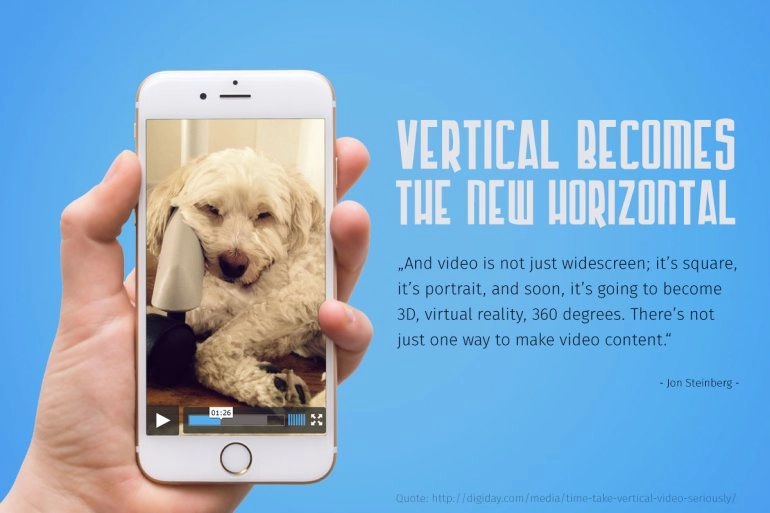Video content is way more than classic widescreen format. No matter if square, portrait, 3-D, 360 Degree or VR – Videos have plenty to offer, especially when it comes to mobile devices. In spite of all the shitstorm against vertical videos; ever since the success of Instagram and Snapchat one thing is clear: vertical becomes the new horizontal.
Billions of photos, selfies and videos are made each day, due to issues of handiness mostly in vertical format. Ever since apps like Snapchat, Pinterest, Periscope and Instagram emerged, this user behaviour has been encouraged additionally. With more than 100 million users per day, Snapchat proves that users are not only willing to consume more content, but also to produce content without turning their mobile phones horizontally. According to the Snap App vertical video ads are being watched until the end nine times more often than their horizontal brothers. The reason of this trend is relatively trivial: Smartphones are mostly held in one hand and upright, that’s why vertical videos generate more user-friendly content than standard video formats.
The world is multiscreen – content is produced and consumed on demand and everywhere. Users want to consume content without restrictions, if on TV, Tablet, Smartphone or any device. 2017 is all about cross-screen content. User behaviour is flexible, so content must be available at any time and on any device, too. Advertisers have to equip and adapt their repertoire accordingly and thus vertically. Videos have mostly been watched on PC or TV, where 16:9 formats were optimal. Nowadays users have more power than ever: Their dwell time, swipes and eyeballs determine the dos and don’ts of 2017. Mobile phones are a completely different media: mobile is vertical and providers adapted according to that. In the end vertical video isn’t just a temporary trend but an actually not really surprising result of the mobile only movement.
Social media shows how it’s done
Even though vertical ads are on the rise, they are far behind their horizontal siblings. Unfortunately it’s not that easy to transform horizontal videos into vertical formats. Content producers have to incorporate social media feeds to avoid accidental cropping and produce the optimal full-screen resolution when creating high-quality vertical videos. To sum up, the three key essences of high user engagement are the following: added value, interaction and vertical.
Social platforms are real pioneers in that field, Snapchat being on top. The app successfully integrated vertical videos with added-value into user experiences. These videos have a huge variety: scrolling up and down plus the well-known swiping left and right addresses user habits perfectly. Even Facebook becomes more vertical: Since the introduction of features like Canvas, video views per day doubled to 8 million. Such vertical updates encourage the upright orientation in feeds and simultaneously feed the user appetite for storytelling in portrait mode.
The ongoing establishment of vertical videos is a result of the general adaption of content to user expectations. Vertical videos won’t completely compensate horizontal formats. Still, they are a successful tool to connect the mobile user with brands and content in full-screen mode.
